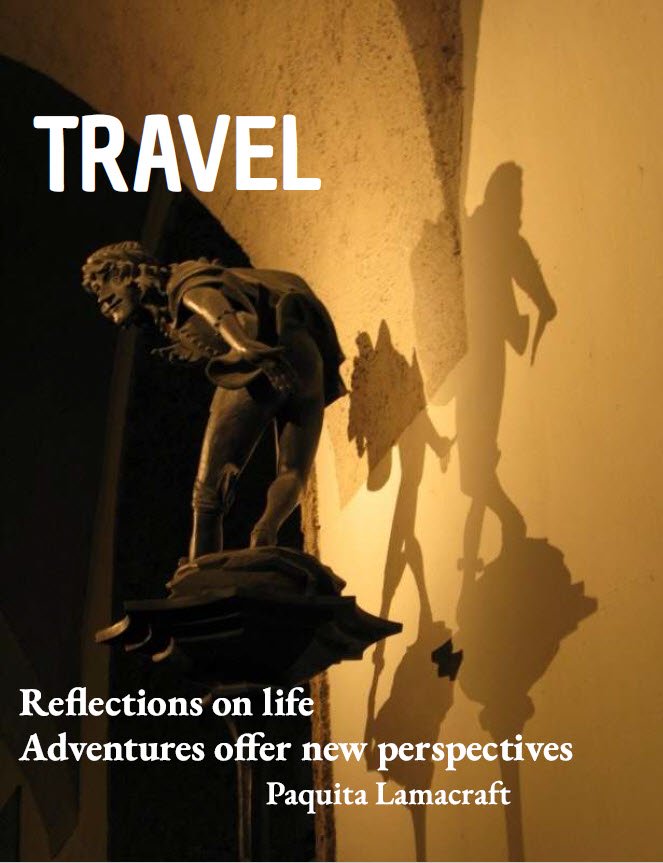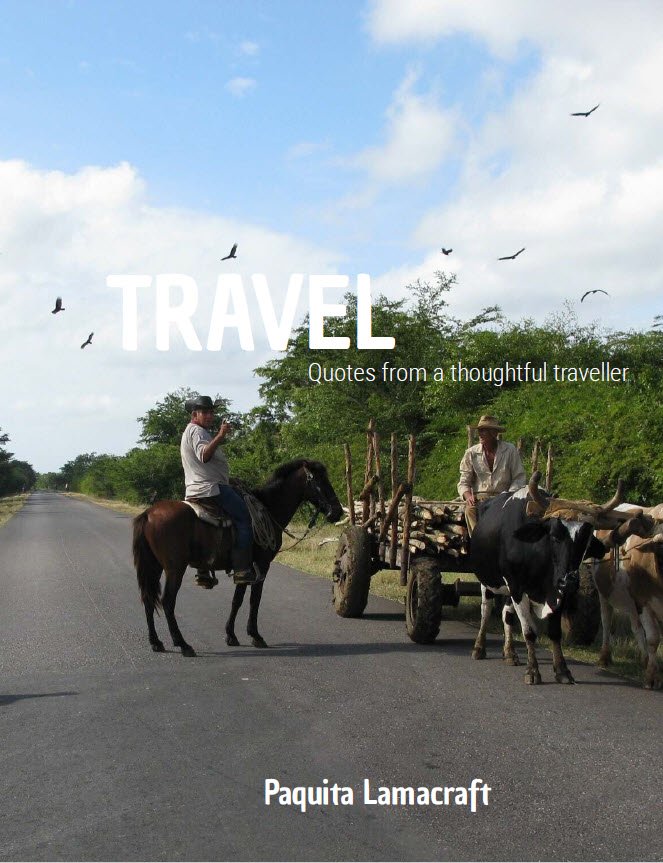Transport in Havana:
creativity on wheels
Apart from the classic cars as taxis, you see people and goods with all sorts of creative transport in Havana.
It was nine years since I had made the last of many previous trips to Cuba. The roads certainly hadn’t improved, as with other infrastructure – but the creativity applied to transport was just as innovative.
Bus transportation now has much improved feature in Havana from the era of the Camelo, seen here in front of the picture theatre on an early trip.
Full of photogenic character, but certainly not missed by the locals, were the camelos - in the past the semi-trailer buses of mass transit
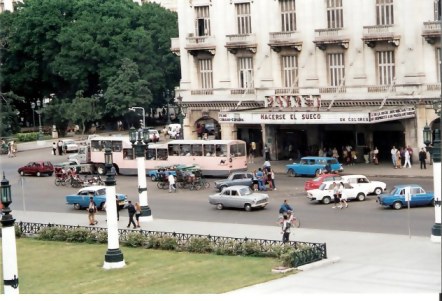
Camelos were still operating during my first visits to Havana. As you can see, they were hardly built to be a bus. The camelo in this picture is the long pink semi-trailer converted into mass transit.
Riding on a packed camelo was an experience to be endured, not enjoyed: they were reputed to be able to carry 300 people. This pack of sweating humanity was a hunting ground for pickpockets and when packed, the camelo was stifling hot.
Since 2008, camelos have been replaced by Chinese buses, but before that, were a typical site in Havana, starting from the bus station in Vedado, and heading out to all major suburbs. Pulled by semi-trailers of different brands and types, they varied in colour.
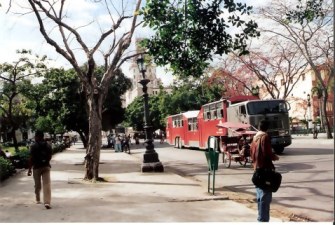
Behind this turquoise Camelo, below, you can see a water truck - a pipa, the water transporter of Havana.
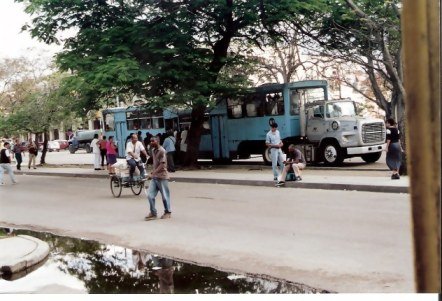
An essential bit of Havana transport is the pipa: the tanker-truck filling household tanks
In 2011, they were still of the same vintage as they had been years earlier, and still valiantly keeping Havana in water.
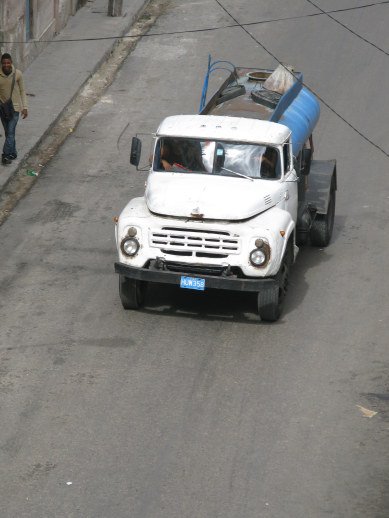
Water comes to many houses by truck because of the decayed infrastructure.
To put in perspective, the main aqueduct, the Albear, was built in the 19th century to support a population of 400,000: now, about 2.15 million people live in Havana.
Water can run out at the most inconvenient times - like when you are in the shower.
I used to stay in an apartment so my Cuban friends could come and visit. This is something they could not do if I were in a hotel and it gave me the opportunity to offer a fiesta or two. I am given to making dinner for 12 to 17 people at a time - and, of course, dancing with them till dawn.
In my apartment - as with theirs - it was not uncommon to have fully shampoo-lathered hair and have the water stop. This meant going to a window or balcony and calling out for more – which came if they had more, and if someone would change the tanks.
Of course if you think about household uses of water, which most of us don’t because we take it for granted – some things are more important to your dignity than others – like flushing the toilet – and so a little pre-planning can be useful.
I was really glad that I had anticipated running out of water during my last big fiesta and dinner party for 17 people. I had a bucket of water on standby when the inevitable happened. It was very well accepted when a guest REALLY wanted the toilet to flush and the tap water ran out.
Of transporting goods upwards - and how to queue for your transport the Cuban way
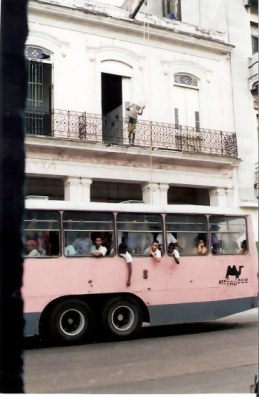
Behind this crowded camelo photographed in 2001, you can see the ingenious method of making purchases from street vendors.
This is still a form of transport in Havana. You just lower your bucket on a pulley from your balcony or window and send down the money and then haul up your goods: saves the transit of lots of flights of stairs.
The queuing system for all public transportation is brilliant. People stand around in a complete jumble, yet when the transportation arrives, ferry or bus, everyone falls into strict order of arrival. This is accomplished in a typical laid back Latin manner.
Unlike the apparent British love of standing in a queue – Cubans simplify this.
What is a queue but the following of one after another in the order of arrival?
Therefore, it is logical that Cubans just want to know who to follow. So, when you arrive at the stop, you call out to ask who is last. The last person answers 'Me' – and all you have to do in future is keep an eye on that person.
Such sanity in the heat. You can then wander off and get an ice, chat with friends in the shade of a slightly distant tree, walk over and examine the flowers – and never lose your place. I loved watching the disorderly groupings of waiting passengers emerge on arrival of the bus or ferry - and board in perfect order without any further engagement but that of knowing the person you follow.
Goods vehicles are of varied and sometimes unexpected types with even more unlikely loads.
When it comes to transport in Havana, there is no shortage of innovation.
This family had worked out how to get the armchair transported.
Balanced precariously on the motorcycle side car, it was held on by the young lad perched on the seat behind Dad.
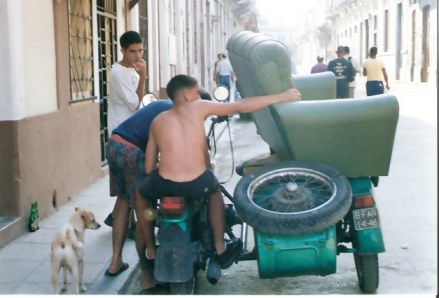
A much wider range of goods are now being transported through the streets since the government has opened up the opportunity for people to start their own self-employment, and with the resulting flourish of street trade.
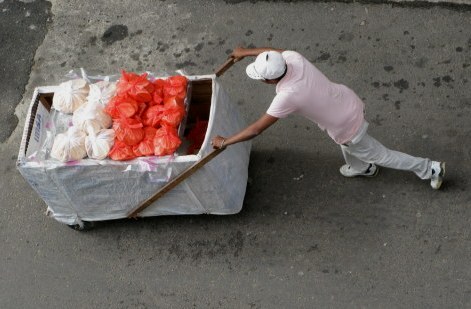
It might be a load of onions and a box of oranges…
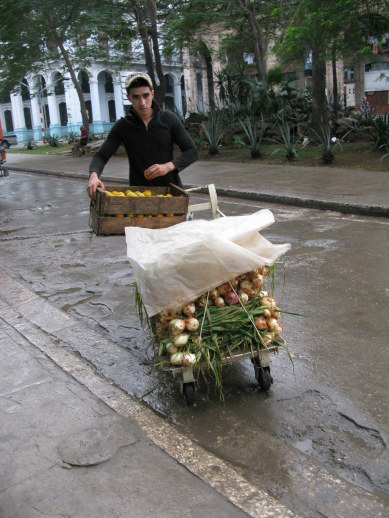
…or a more varied selection of vegetables…
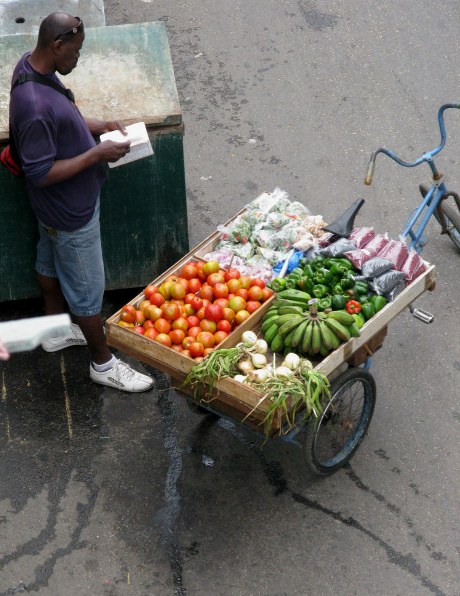
…or thick sausages stored beneath a cooling plastic cover
as they lie in their cardboard box to be relished by residents of Central Havana.
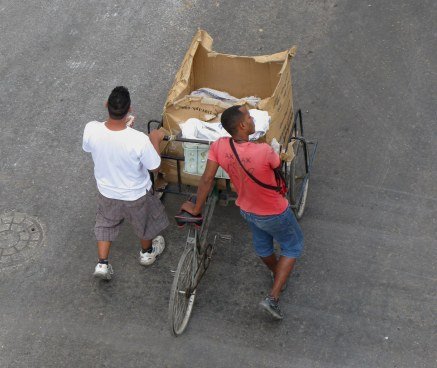
The creative adaption of all sorts of structures with wheels attached that make up transport in Havana never ceased to gain my respect.
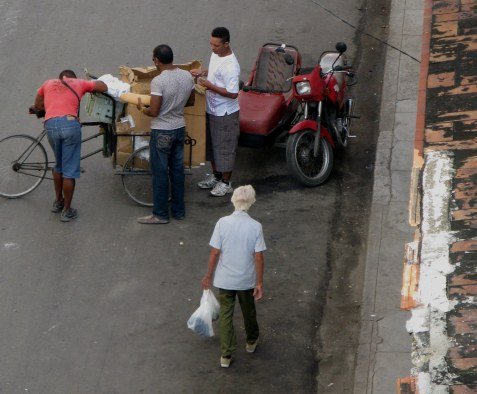
Sometimes the load is just a bit too much and requires a short break before it can be trundled over the pot-hole filled streets to its destination – as with these bags of onions.
I estimated that each bag may be a bit over 45kilos (100lbs) so this weary chap had hauled 225 kilos (500lbs) on these tiny, inadequete wheels. He deserved a rest.
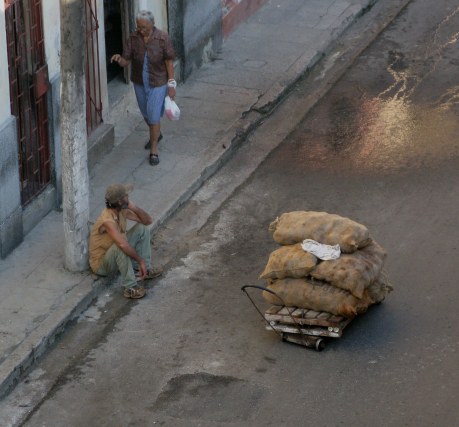
Transporting people by car is a classic experience in Havana
For passengers, the range of cars that offer transport in Havana is extensive - and their condition variable.
Some are quite beautifully restored…although they may reside beside houses that are not.
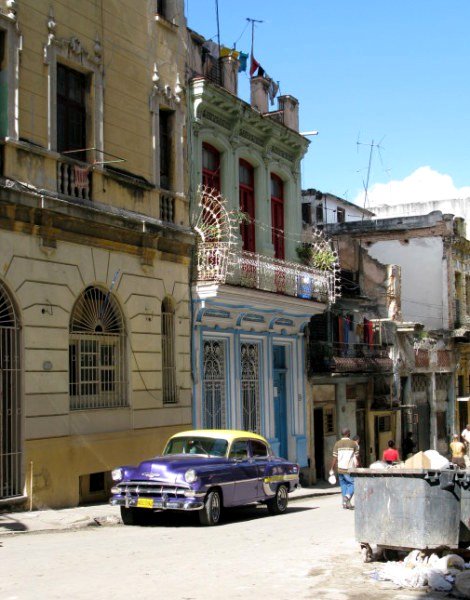
This classic Dodge in the restoration area of Havana’s Old City has had both money and talent applied to its restoration.
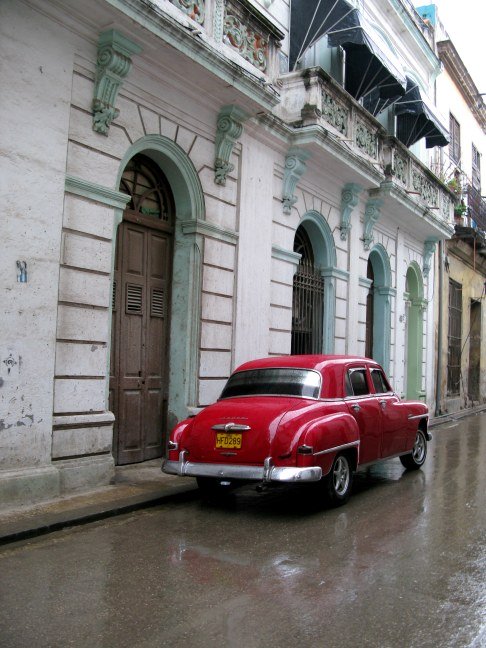
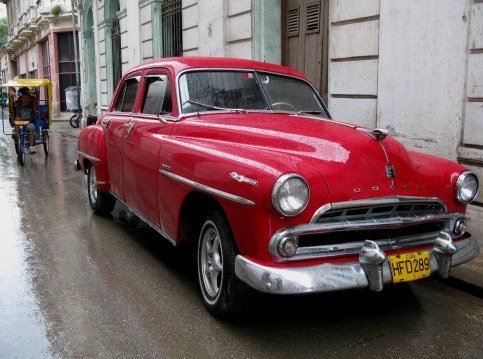
Other classic cars run loudly - and are awaiting a paint job.
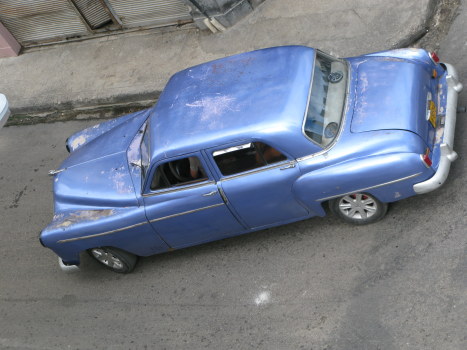
Classic cars in Havana are living testimony to creative invention for repairs
Some of these are a source of constant challenge to maintain. But with no shortage of innovative thinking, there is always the opportunity to improvise a service bay from 'Havana Old Town' drainage channels.
Transport in Havan demonstrates the old adage: necessity is the mother of invention.
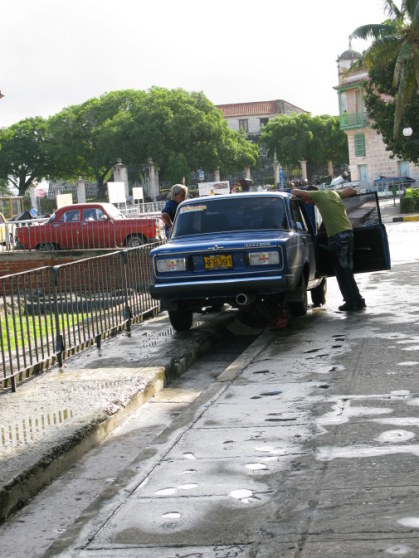
It is not always that you can plan for service, and broken down cars are often to be seen.
In our case we had something of an epidemic of flat tyres.
I never saw a tyre changed so quickly or with such good humour, as smart white shirt was hung on the open front car door, and a well-practiced tyre change took place.
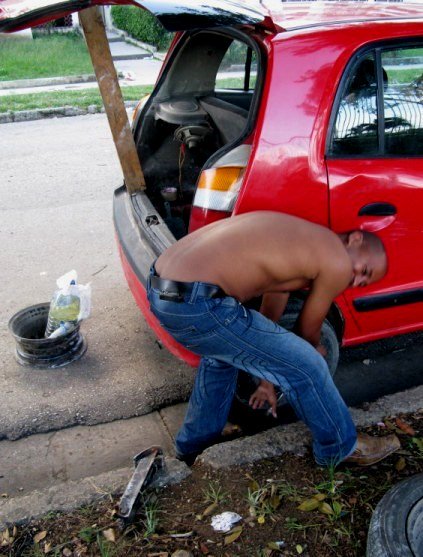
We had been nursing this tyre along by stopping to fill it with air at every opportunity, but staying to visit friends a bit long, we emerged to find it was very flat - but as my brother would have laughingly said: Just on the bottom.
The front one on the near side went flat shortly afterwards: that one was quite without hope, as the steel from within the tread had actually finally emerged from the rubber itself.
There is only so much re-tread that one can successfully implement before the amount of rubber within which the steel 'belting' sits is less than the steel itself. We had reached that point.
Now THAT is wear and tear.
With another friend, we peered through the taped windscreen after a night-time accident had left a head imprint in the glass.
It was fascinating to be party to the method of finding a new one – not an easy job where shopping goes by local knowledge and word-of-mouth. No yellow pages here.
Jeepies - vestiges of past military transport in Havana
On another occasion we rode in one of the many 'Jeepies'.
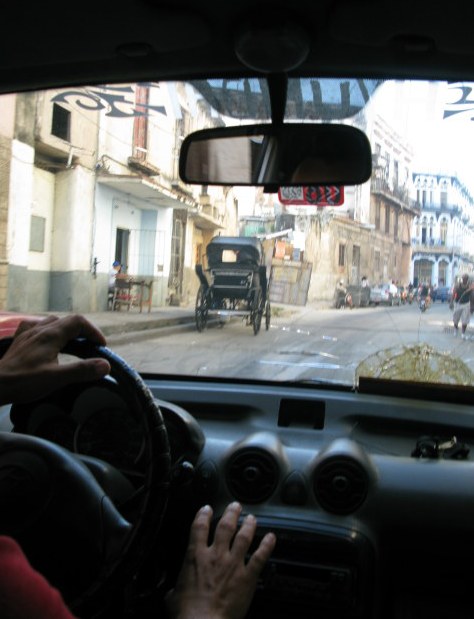
Unfortunately it was quite dark so I just have photos of the inside that give some 'feel' of the challenges of owning a vehicle in a country where even if you had the money, finding the right parts needed could be a lifetime job.
The seats reminded me of when I learned to scuba dive in Australia. Without the proper kit to wear, I instead donned a wetsuit hood, my brother’s rugby shirt and rugby socks (so the borrowed flippers would fit me), and an old army webbing belt with lead ingots attached for weights (These were made from melted down lead poured into the hollows of bricks to cool) .
I had spat on my mask to wash it out in the sea and was up to my knees at the water's edge. Two little boys stood nearby and were having a debate:
“It’s a girl”.
“No. It’s not a girl.”
I finally settled the dispute: “It’s a girl in a bikini under all this”
In my wetsuit hat I was streamlined just from the top of my head to the neck.
Here in Havana, the Jeepie seats were similarly streamlined – from the headrest to the seat. The rest was chaos, but underneath it all, it ran like a tank!
Such is the nature of the varied transport of Havana.
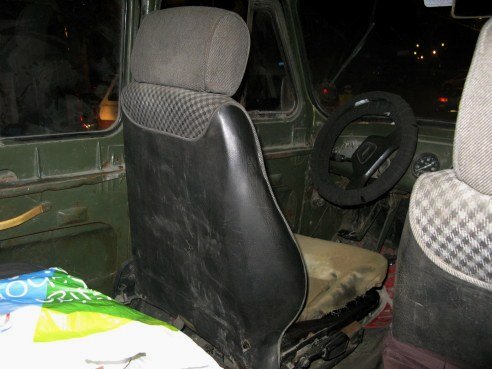
Of course there are modern vehicles – mostly for tourists, but also some registered to locals.
This Lada beside a modern bus in Boyeros district of Havana is not that aged, but I loved the stickers stating that it was 'immortal'.
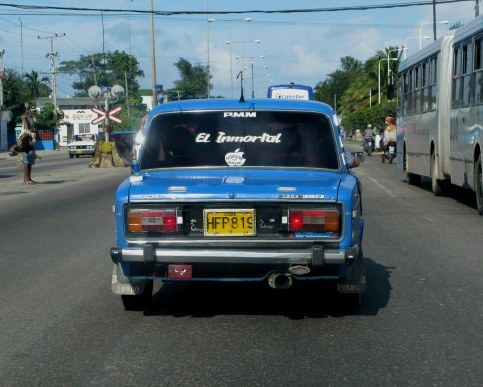
As I took this photo I noticed the bird seller in the middle of the road, (look on the left of the photo)strategically placed where everyone slows down to go over the railway crossing.
As you can see, the birds are hanging upside down, but not dead and trying to raise their heads, poor things.
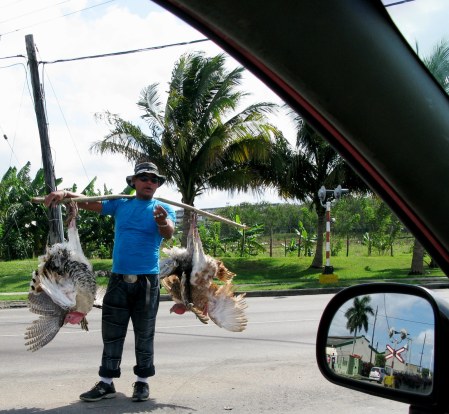
Two and three-wheeled transportation abounds in Havana
Types of motorcycle vary from the classic to the more modern.
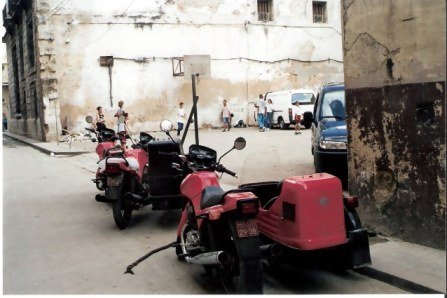
The cheapest form of fuel being your own feet, there are hundreds of pedalos whose drivers are always asking people if they need a taxi.
Many come with a sound system that blasts the most popular hits from Reggaeton at full volume, no matter what the hour.
This driver was waiting at the busy intersection by the Capitol Building and you can well see the pedalo construction: two sturdy wheels at the rear and a clever welding job for the seat, for the front wheel, and to hold the roof on.
It made a contrast in ingenuity from the little bumble-bee fibre-glass taxi beside it.
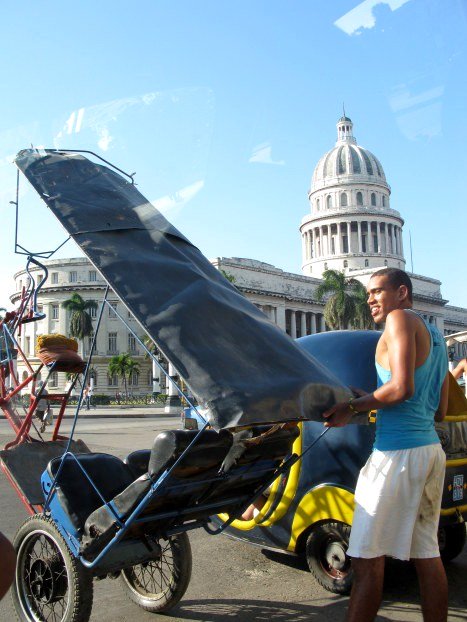
These bumble-bees beetle around the city centre of the Old Town. They are official transport in Havana and therefore relatively standard - and not nearly as much fun.
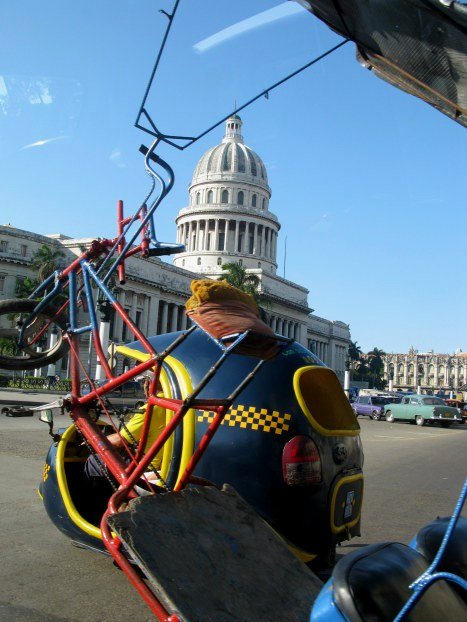
The roof of a pedalo is a piece of creativity in itself.
Those I saw from my balcony in central Havana varied.
Most had a similar shape and size – but the materials from which they were made showed the official/unofficial 're-cycling' that is continually going on in Cuba - and especially in cities like Havana.
This one had once been an advertising hoarding for a convention in Havana.
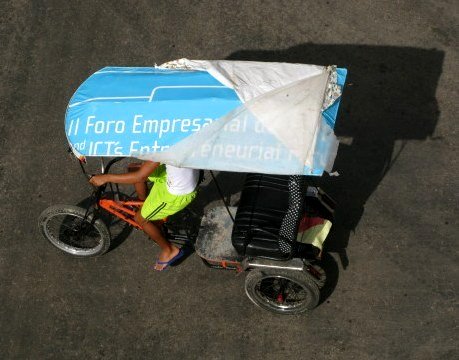
Taking a pedalo can be quite a good option now it is legal for tourists to ride them – for they fit between the tilted road block barrages that are common in the Old City of Havana, Havana Vieja.
A word of warning: prices are what can be politely termed 'flexible (as in whatever they reckon the market will bear and YOU are the market)
Negotiate your price before you ride.
If not, you may be left to set your own price as to what is fair - and what you think is fair is usually way higher than what the price would have been. This I discovered after riding with my Cuban friends along a route which I had previously taken alone.
Long live the four footed carriage: transport in Havana is not all motorised
There are many ways to get from one point in your local suburb to another.
One is to take a mule cart.
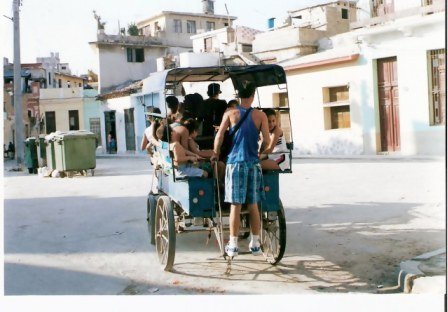
This one nearly ran me over as I was taking a photo and looking in the other direction.
It quickly disappeared at a trot around the corner of the barrio.
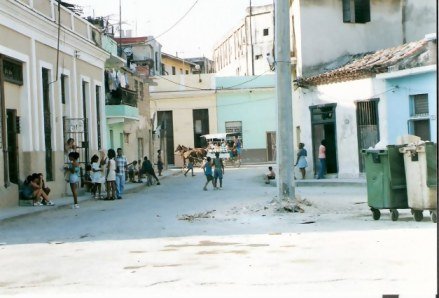
Crossing the Plaza de la Revolución – Revolution Square - between the vehicles, another mule cart trundled along, carrying bales of hay.
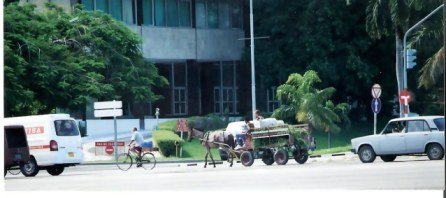
Plaza de la Revolución – Revolution Square - is a something you must see, but for me it is one of the less attractive tourist destinations in Havana.
Most people make the effort just to see the famous Che Guevara tribute on the wall of the Ministry of the interior, with his famous quote Hasta la Victoria Siempre (Forever Onwards Towards Victory)
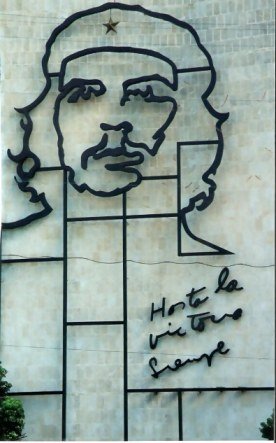
On the Square, the José Martí Memorial Tower (109m or 358 feet) and statue (18m or 59 feet) are tall enough to exemplify a man with towering principles.
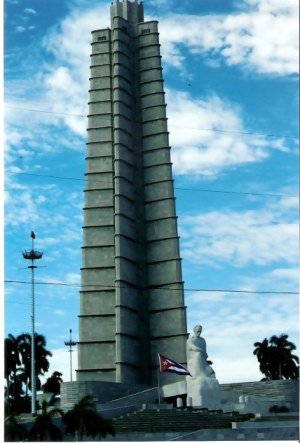
Nevertheless, I prefer his Malecón statue. I think he would be happier there – overseeing the harbour - not here amidst government offices.
Returning to Habana Viejo, the Old Town horse drawn carriages wait for the evening visitors. Here, a carriage driver relaxes in the shade.
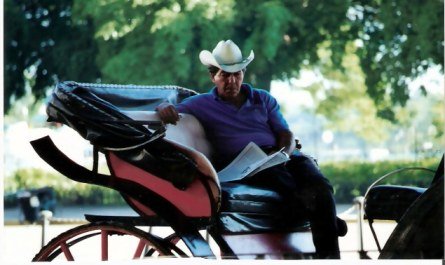
I was reminded of the Spanish Proverb:
How beautiful it is to do nothing,
and then to rest afterward
More Cuban Pages here:
Havana pages
Agricultural
Fair
The
Art of Dominoes
Havana
Back Street Rambles
Capitol
Building
Havana
Classic Cars
Malecón
- Fish and Philosophy
Havana
Angels
Havana
Grandeur
Political
Demonstration
Street
Water Skiing
Trinidad de Cuba pages
Palacio
Cantero Museum
Trinidad
de Cuba
Remedios
Remedios
churches
Parrandas
& Pedlars
Other Cuban pages
CienfuegosAlmendares River Voodoo
Backroad Travel
Bay of Pigs
Viñales - Pinar del Rio
